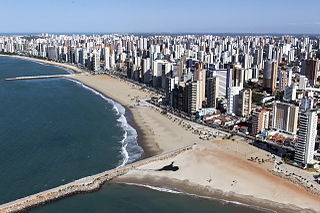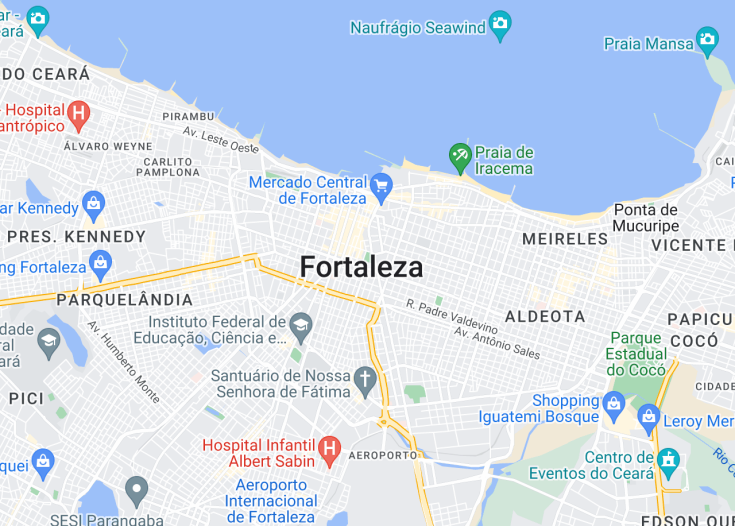Fortaleza, the vibrant capital of Ceará in northeastern Brazil, is celebrated for its stunning beaches, rich cultural traditions, and dynamic nightlife. It serves as a gateway to picturesque coastal villages like Canoa Quebrada and is noted for its historical architecture, such as the Fortress of Our Lady of the Assumption. Visitors are drawn to its extensive urban parkland, diverse shopping venues, and lively music scene, making Fortaleza a quintessential example of Brazilian zest and charm.
Plan your visit between July and December when the weather is most favorable. This period avoids the heavy rains, making it perfect for beach outings and city tours.
Don’t miss experiencing the traditional Forró dance, particularly during the Festa Junina, a festival held in June celebrating Brazilian folklore with vibrant music and regional food.
Top things to do & see in Fortaleza
Select the following sights and activities to discover best tickets and tours available in Fortaleza.
Fortaleza: A Vibrant Gateway to Brazil’s Northeast
| Country | Brazil |
| Time in Fortaleza | GMT-3 |
| Language spoken | Portuguese |
| Population | 2.7 million (2021, IBGE) |
| Currency | Brazilian Real (R$ / BRL) |
| Airports | Pinto Martins – Fortaleza International Airport (6 mi / 10 km). |
Fortaleza, the state capital of Ceará in Brazil, is famed for its rich history, vibrant culture, and beautiful beaches that attract tourists from around the globe. Established in 1726, the city has grown into a major urban center in northeastern Brazil. Its coastline is dotted with impressive urban beaches like Praia do Futuro, Meireles, and Iracema, each known for their bustling nightlife and local cuisine. Fortaleza also serves as a jumping-off point for other stunning destinations in the state such as Jericoacoara and Canoa Quebrada.
Apart from tourism, Fortaleza is an economic engine in the region with strong textile, footwear, and food industries. Cultural expressions such as the traditional “Forró,” a genre of Brazilian music and dance, and the colorful handmade fabrics weave the city’s identity deeply into its daily life. Additionally, the city hosts the Carnival of Fortaleza, one of Brazil’s vibrant celebrations of music and dance that reflects its rich cultural tapestry.
The city’s infrastructure supports its status as a key transport hub in northeastern Brazil, highlighted by the Pinto Martins – Fortaleza International Airport which facilitates both domestic and international flights. Fortaleza’s urban mobility is further enhanced by modern transportation systems including extensive bus routes and a metro system, making it easily navigable for both residents and visitors.
The unique blend of urban life with tranquil beach scenes makes Fortaleza a unique destination to explore. It provides a perfect example of Brazil’s dynamic nature, combining modern amenities and traditional Brazilian culture in one scenic and lively location.
Where is Fortaleza?
Located in Northeastern Brazil on the Atlantic coast, Fortaleza serves as the state capital of Ceará.
Distances:
| Route | Distance by car | Time by car |
|---|---|---|
| São Paulo to Fortaleza | 1,950 mi | Approx. 29 hours |
| Rio de Janeiro to Fortaleza | 1,620 mi | Approx. 25 hours |
| Brasília to Fortaleza | 1,380 mi | Approx. 20 hours |
What is Fortaleza famous for?
Fortaleza is famous for its beautiful beaches, vibrant cultural festivals like the Fortaleza Carnival, significant handicraft markets, and as a hub for Brazilian music and dance, particularly the Forró.
History
Fortaleza, the capital of the Brazilian state of Ceará, has a rich history that spans several centuries, marked by colonization, cultural fusion, and economic transformation. The city’s narrative begins long before the arrival of Portuguese settlers, with its roots deeply entwined with the indigenous populations.
Before 1600: Indigenous Era
The area that is now Fortaleza was originally inhabited by the indigenous Potyguara tribe. These early inhabitants lived primarily by fishing, hunting, and agriculture, and had developed complex societal structures well before European contact.
1603-1822: Colonial Foundations and Development
The formal history of Fortaleza begins in 1603 when the Portuguese, led by Captain Pero Coelho de Souza, constructed a fort called Forte Schoonenborch. This fort was established as a measure against French incursions who were allied with indigenous groups. Over the next two centuries, Fortaleza grew slowly under Portuguese rule, becoming a significant outpost on the northeastern coast of Brazil, mainly serving as a hub for the cattle trade and as a strategic military location.
1822-1889: Growth and the Empire of Brazil
With Brazilian independence in 1822, Fortaleza was elevated in status from village to town and named the capital of Ceará. The following decades saw Fortaleza expand economically, driven by cotton and sugar cane cultivation. Despite economic growth, social issues such as slavery were prevalent until Brazil’s abolition of slavery in 1888, which had a profound impact on the region’s socio-economic dynamics.
1889-present: Modernization and Urbanization
Entering the 20th century, Fortaleza underwent significant changes. The city modernized rapidly, establishing itself as a critical regional center for commerce, culture, and politics. Today, Fortaleza is recognized for its extensive urban beaches, vibrant cultural scene, and as a dynamic economic hub in Northeastern Brazil, maintaining a blend of historic heritage and modernity that continues to shape its development.
Visit Fortaleza
What to see and do in Fortaleza
Fortaleza offers a plethora of attractions and activities that cater to a diverse range of interests. From stunning beaches to rich cultural experiences, there is something for everyone:
- Explore the Beira Mar Avenue, a vibrant area with numerous markets, restaurants, and the famous Iracema Statue.
- Visit the iconic Fortaleza Cathedral, a stunning example of Gothic-Romantic architecture with a capacity for 5,000 people.
- Enjoy the sun and surf at Praia do Futuro, known for its excellent facilities and lively barracas (beach clubs).
- Discover the rich history and culture of the region at the Ceará Museum of Culture and Art.
- Take a day trip to the nearby beach town of Cumbuco, famous for kitesurfing.
Festive Fortaleza
Fortaleza is bustling with energy and hosts various events throughout the year. Notably, the Fortaleza Carnival, an extravagant pre-Lenten celebration, transforms the city into a vibrant spectacle of costumes, dances, and music. The Ceará Music Festival, typically held in October, is another significant event, drawing national and international artists. These events vividly showcase the city’s dynamic cultural tapestry.
Best time to visit Fortaleza
The ideal time to visit Fortaleza is between July and December, when the weather is most favorable. This period avoids the heavier rainy season from January to June, offering sunny days ideal for beach activities and city exploration.
is Fortaleza worth visiting?
Fortaleza is undoubtedly worth visiting. With its unique blend of beautiful beaches, rich cultural heritage, and vibrant city life, Fortaleza offers a compelling mix that appeals to both relaxation-seekers and cultural enthusiasts. The city’s friendly locals, diverse culinary scene, and myriad of leisure activities ensure a memorable experience for all who visit. Whether soaking up the sun on its gorgeous coastlines or exploring its rich historical sites, Fortaleza promises a fulfilling escape.









